Is Epiphone Le Hummingbird by Artist Better Than Pro 1 Plus Review
Epiphone: 140 Years
Epiphone is one of American's oldest and most revered instrument makers. Since 1873, Epiphone has made instruments for every manner of popular music and in 2013 will celebrate its 140th anniversary.
The name Epiphone evokes both history and the spirit of invention. The "House of Stathopoulo" has played a cardinal role in every dandy musical era from the mandolin craze of the early 1900s to jazz age guitars of the 1920s; from swing era archtops through mail service-state of war pop, jazz, r&b, and early on stone north' roll; and from the "British Invasion" to heavy metal, punk, grunge, and thrash. And now, in the 21st century, new Epiphone technical breakthroughs such as the ProBucker™ pickup, serial parallel switching, built-in KillSwitch™ pots, the Shadow NanoFlex™ and NanoMag™ pickup systems, and premier acoustic/electrical guitars with the eSonic™ preamp take brought Epiphone to a new generation.

The story behind Epiphone's improbable rise from a small family repair store to a worldwide leader in the manufacture of quality instruments could hands exist transformed into the cracking American novel. But this story is true.
The story of Epiphone begins in the mountains of Greece and threads its mode to Turkey, beyond the Atlantic to the immigrant gateway of Ellis Island, and into the nightclubs, recording studios, and coast-to-coast radio broadcasts of Manhattan in the 1920s and 30s. It's the story of both hard earned adroitness passed from father to son and the incessant American bulldoze for innovation.
The variety of musicians that walk through Epiphone's history is remarkable. Jazz greats like George Van Eps, country pioneers like Hank Garland, bluesman John Lee Hooker, and scores of mandolin, archtop and steel guitar players used Epiphone instruments daily over nationwide broadcasts. There are unlikely heroes and tinkerers in the Epiphone story as well, like guitar pioneer Les Paul, who worked nights in the Epiphone factory in New York City to create "the Log", his primordial version of what would eventually exist called the "Les Paul." The Beatles' bassist extraordinaire Paul McCartney choose an Epiphone Casino as his offset American made guitar and John Lennon and George Harrison speedily followed. The Casino appeared on every Beatles album from Aid through Abbey Road. And today, Epiphone can be heard on albums past Gary Clark, Jr., Alabama Shakes, My Chemical Romance, Joe Bonamassa, Nirvana, Johnny Winter, Zakk Wylde, Motorcar Caput, Dwight Yoakam, The Strokes, Slash, Jeff Waters, Paul Simon, Radiohead, The Waco Brothers, Lenny Kravitz, and Paul Weller.
If a time machine could transport today's Epiphone players to Epi Stathopoulo'southward Manhattan showroom of 60 years ago, when it was a gathering place for all the Big Apple's best players, generations of musicians would agree that Epiphone has always been the "House of Stathopoulo." And today, Epiphone is nonetheless innovating, yet delighting musicians, and still frustrating competitors with daring designs and superb quality.
"Epiphone e'er fabricated a skillful guitar," Les Paul once said. And that later on all, is what all musicians are looking for.
The opening affiliate of the Epiphone story begins near 140 years ago in Kastania in the mountains overlooking the ancient city of Sparta, Greece. Family unit legend tells that in 1865, Kostantinos Stathopoulo left Kastania and journeyed to Magoula in the Eurotas valley to annals the nativity of his son, Anastasios. Petty else is known of the family unit until 1873, around the time of Anastasios's 12th birthday, when the Stathopoulo family left Greece for the coast of Turkey where they settled in Smyrna, a bustling seaport with a potent Greek immigrant population of merchants and craftsmen. There, Kostantinos established himself every bit a lumber merchant. Kostantinos would often accept Anastasios with him on work trips throughout Europe, where the boy observed his father'southward trade and learned about tonewoods. During this time, the family established a store in Smyrna selling and repairing lutes, violins and bouzoukis. By 1890, Anastasio's local reputation as a talented luthier was providing plenty concern that he opened his own instrument factory. He married and started a family. His offset son, Epaminondas, was built-in in 1893, followed by Alex, Minnie, Orpheu, Frixo and Ellie.
Loftier taxes imposed on Greek immigrants under the Ottoman Empire made life difficult for the Stathopoulo family and at the age of forty, Anastasios boarded a ship to the United States. Public records from 1904 list A. Stathopoulo living at 56 Roosevelt on Manhattan'southward Lower East side, home to many other Greek and Italian immigrants. Once in America, Anastasios continued his instrument merchandise. He quickly alloyed the pace of American business practices. He filed his starting time and only patent March 25, 1909 for an Italian fashion bowl back mandolin. Anastasios's instruments at present carried labels in English:
A. Stathopoulo
Manufacturer, repairer
of all kinds
of musical instruments
Patentee of the Orpheum Lyra
New York, 1911 U.Southward.A.
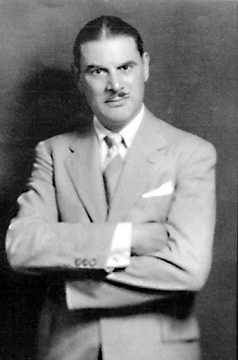
Epi, equally the oldest child was known, easily merged into American life, attended Columbia University, and graduated with honors. With Anastasios crafting and selling his instruments on the footing floor and family living upstairs, the line between work and home life became increasingly blurred. Epi and Orpheus ('Orphie') were soon helping out in the store, now located at 247 Westward 42nd Street.
Epi was only 22 when his male parent Anastasios died. As the oldest son, Epi was charged with keeping the business organization going. Already a slap-up student of his male parent's piece of work and eager to establish himself in the marketplace, Epi replaced the old instrument characterization of his father's with a new one: "The Firm of Stathopoulo, Quality Instruments Since 1873." Already an amateur designer and inventor during his apprenticeship, Epi at present took a lead role in the company and was granted his commencement patent for a banjo tone ring and rim construction - 1,248,196 given to Due east. A. Stathopoulo.
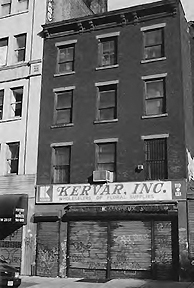
At his mother's death in 1923, Epi assumed ownership of the controlling shares of the business and phased out most of the onetime world style mandolins. Instead, he introduced the Recording line of banjos, then the most popular instrument in post-World War I America.

The Recording line was listed in advertisements alphabetically: Recording (A) at $125, the Bandmaster at $200, the Concert at $275, and the De Luxe, which sold for $350. Epi continued to expand equally his business organization and reputation for quality work grew. The family unit acquired the "stock, goodwill, and modern machinery" of the Farovan Company instrument plant in Long Island and incorporated. Epi gave the now growing business organization a new name--Epiphone. "Epiphone" referenced non just his own proper name, but the Greek word for sound--phone. It was also an echo of the Greek discussion epiphonous, meaning 1 sound on another, the son building on the dreams of the male parent.
Epi took the title of president and general manager and announced in merchandise publications and advertisements that "the new policy of business concern and all interest volition be devoted to the production of banjos, tenor banjos, banjo mandolins, banjo guitars, and banjo ukuleles nether the registered trademark proper noun of 'Epiphone.'"
Epi retained most of the Long Island factory's skilled workers. Production increased. Quality improved. Ornate banjo models were introduced in 1927 including the Emperor tenor banjo ($500), the Dansant ($450), the Concert Special ($300) and the Alhambra ($200). Business concern was good and the Stathopoulo brothers, with Orphie now serving as Vice President, moved the company to 235-237 West 47th Street.
By 1928, The Epiphone Banjo Company were making banjos for Selmer/Conn and the Continental Music line of stores, a major distributor of instruments. In 1928, Epiphone too introduced their beginning line of audio-visual guitars to compete with the visitor that Epi determined was Epiphone'south greatest rival, Gibson.
The Recording Series
The Recording serial of acoustic guitars, like the banjo line, were each identified past a letter ('A' through 'Due east') and were notable for their unusual body shape. The instruments combined spruce and laminated maple and were available every bit an archtop or flattop.
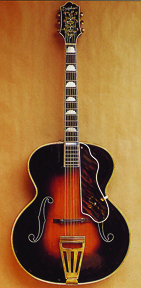
The Recording guitars were not initially a success. Ane problem was a lack of glory endorsement. The other was a lack of volume. The Recording guitars were as well pocket-size and arguably too ornate, particularly in comparison to the size and book of Gibson'south popular Fifty-5, which was introduced in 1922 and had speedily become an industry standard. The L-five had project, tone, and complimented rhythm sections with a tuneful timbre and snare drum like attack.
Though banjo sales remained steady immediately after the stock market crash of 1929, Epi was keenly aware that archtop guitars were becoming more than pop and that his main competitor in quality and pattern was Gibson. In 1931, the Epiphone Banjo Company appear the introduction of the Masterbilt line of guitars featuring 7 carved acme, f-hole style archtops ranging in cost from $35 to $275.
It wasn't difficult to come across the L-5's influence on the new Epiphone line. Epi's guitars had like f-holes, pegheads, and even a similar name to the Gibson Master Model range. Epi did go along to distinguish his company with model names that musicians could easily remember and be proud to own.
The Epiphone Masterbilt line included the De Luxe ($275), Broadway ($175), and the Triumph ($125). The De Luxe, co-ordinate to advertisements, featured a "carved spruce tiptop, flame curly maple back, violin construction throughout, large "f" holes, black and white binding and sugariness resonant tone."
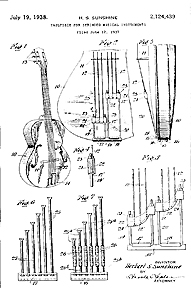
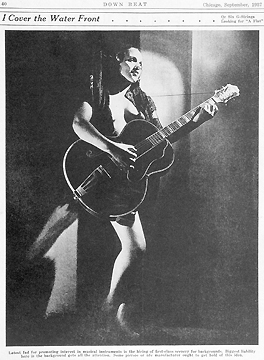
Throughout the 1930s, the rivalry betwixt Epiphone and Gibson would veer from friendly sparring to all-out guitar warfare. Gibson retaliated with a new archtop design in 1934, increasing the body width of its existing models and introducing the king-sized Super 400 (named after its $400 price tag). Non to exist outdone, Epi replied the following yr with the elevation-of-the-line Emperor, which raised the stakes with a slightly wider body and a provocative advertizing campaign featuring a nude woman holding an Epiphone archtop. In 1936, Epiphone struck again, increasing the size of its De Luxe, Broadway and Triumph models by an inch making them 3/eight" wider than Gibson'due south archtops and one of the most distinctive instruments on the market.
By the mid '30s, Epiphone guitars were considered to be among the all-time in the world, and Epi himself was enjoying the patronage of the almost respected players on the scene. Epiphone went inter-continental with a distribution deal with Handcraft Ltd. of London, and a new exhibit opened at 142 Due west 14th Street in a 7-story beaux-arts style edifice nearly Lilliputian Italia.
The new edifice included an advertised "state-of-the-art" research and development laboratory. The Epiphone showroom on the commencement floor was both the visitor's headquarters and a hangout for musicians. On Sabbatum afternoons, Epi would open up brandish cases and let the leading guitarists of the time artists like Al Caiola, Harry Volpe, and Les Paul, jam equally people listened for the sidewalk.
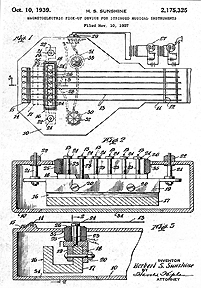
Epi was likewise enlightened of the success of Rickenbacker'south electrical steel guitar models. In 1935, Epi made his move with the introduction of the Electar Series (originally known as Electraphone). Among Epi's unique design features included individually adaptable pole pieces on the Master Pickup. The Electar line furthered the reputation of Epiphone as an innovative make. By the tardily '30s, sales had doubled. Collaborations between Epi and other companies became more frequent. In July 1936, Epiphone showed off several new models at the National Association of Music Merchants (NAMM) show at the Stevens Hotel in Chicago, including an electrified piano created with the Meissner Inventions Visitor in Milburn, New Bailiwick of jersey. Epiphone too began selling amplifiers after meeting electronics enthusiast Nat Daniel, a friend of Les Paul's. Daniel perfected an innovative push/pull wiring blueprint, which today is a fixture in many amplifiers. Epiphone reps heard Daniel'due south amps and hired him to build chassis likewise every bit new designs. (Daniel would go on to start the Danelectro line of guitars and amps in the 50s).
By the finish of the '30s just prior to America's entry into World War 2, the rivalry between Epiphone and Gibson showed little sign of abating. In 1939, the 2 firms introduced similar 'pitch-irresolute' Hawaiian guitar designs, a forerunner to the pedal steel. When Gibson introduced a line of violins, Epiphone struck back with a line of upright basses. It took the outbreak of the Globe War Ii, the scarcity of fundamental materials, and the virtual shut down of guitar production around the world to ring the bong on the rivalry.
HARD TIMES
The war changed everything. Earlier the bombing of Pearl Harbor in 1941, Epiphone was a consumer favorite and industry leader. By the finish of the war in 1945, the company had lost its greatest asset when Epi died of leukemia. Epiphone shares and control went to younger brothers Orphie and Frixo.
Problems emerged slowly at first. Epiphone continued to disharmonism with Gibson, each introducing electrical cutaway versions of their top archtops. Pickups continued to be refined and players connected to appear onstage with Epiphone guitars. From the outside, it seemed to be business as usual.
But cracks presently appeared both on the product line and in the boardroom. The Stathopoulo brothers argued over the future of the visitor and in 1948, Frixo sold his shares to Orphie. The company's reputation for craftsmanship and innovation that Epi had congenital in the '20s and '30s did not survive the war years. Tastes were changing and Epiphone'south products seemed traditional and out of pace. The Epiphone factory moved from Manhattan to Philadelphia in 1953 to avoid a matrimony clash merely many of the company's craftsmen refused to leave New York.
EPIPHONE AND GIBSON
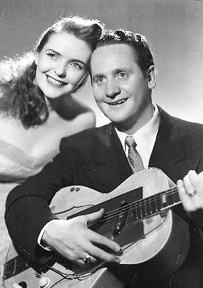
In the early '50s, Epiphone's former champion and favorite belatedly night tinkerer Les Paul became a household name with a television show, a radio program, and chart-topping hits, all played with his proper noun-brand Gibson Les Paul. Les had been perfecting his solid body guitar design in the Epiphone factory and when Fender emerged with their Telecaster, Gibson President Ted McCarty made Les Gibson's kickoff solid trunk electrical guitar endorser.
Equally Epiphone'southward fortunes continued to reject, Les suggest McCarty reach out to Epiphone. McCarty took the advice and reached out to Orphie, expressing Gibson's interest in Epiphone's critically acclaimed upright bass division which Gibson had non picked up again afterwards Globe War Two. When Orphie replied in 1957, McCarty was offered the entire Epiphone visitor, including the remaining inventory of the Philadelphia manufacturing plant, for $twenty,000. McCarty accepted on behalf of Gibson. The Stathopoulo family was out of the instrument business organisation.
Though McCarty'south original intention was to bring the Epiphone bass models into the Gibson catalogue, by 1957, he inverse his listen. Instead, every bit McCarty wrote in a memo that yr, the Epiphone brand would exist revived with a new line of instruments.
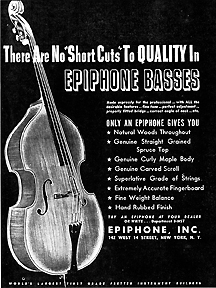
McCarty's marketing programme was to offer Gibson-fabricated Epiphones to dealers who were peachy to win a Gibson contract, only had not even so proven themselves as profitable dealers. (The right to sell Gibson models was hotly contested between dealerships at this time). It was the perfect solution. Dealers would get a Gibson-quality product without treading on the toes of dealers who already sold the Gibson line. The entire Epiphone operation was relocated to Kalamazoo, Michigan. Epiphone was back in business.
A NEW Showtime
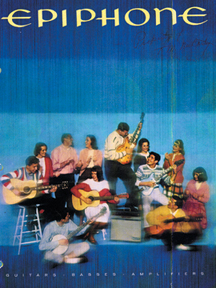
Epiphone wouldn't stay in the shadow of Gibson for long. When a new line of instruments started filtering through to dealers in 1958, information technology became clear that the two brands now had three separate identities. On one paw, Epiphone at present listed budget-conscious versions of existing Gibson models. Alongside these models, however, were also recreations of classic Epiphone designs such as the Emperor, Deluxe and Triumph forth with a option of new designs like the semi-hollow Sheraton, the solid body Moderne Blackness, and flat-top acoustics like the Frontier, whose square-shouldered torso mode was a first for whatever musical instrument from the Gibson Kalamazoo factory. Combined with a new line of amplifiers, information technology was clear that Epiphone designers were quickly establishing their independence.
The grand unveiling of the Epiphone line took place at the NAMM trade show in July 1958 with the electric Emperor equally the flagship model. The bear witness itself would generate orders of 226 guitars and 63 amps, a modest return. Over the next few years, Epiphone would sell iii,798 instruments in 1961 and by 1965 account for xx% of the full instruments shipped out of Kalamazoo. Even more impressive was the prestige of the guitars themselves. In the early 1960s, the Epiphone Emperor toll significantly more the top-of-the-range Gibson Byrdland, while 1963's deluxe flat top Excellente, was $100 more than than the J-200, and fabricated of rarer tone woods.
The early on 60s brought the explosion of folk music, and Epiphone was ready to cater to information technology, introducing the Seville classical guitar (with and without pickups) in 1961, also equally the Madrid, Kingdom of spain and Campaign models. In 1962, Epiphone listed a twelve-string, the Bard (on which Roy Orbison composed "Oh, Pretty Woman" and "Simply The Lonely") along with a smaller version, the Serenader. In 1963, the Troubadour, steel string apartment elevation guitar was introduced.
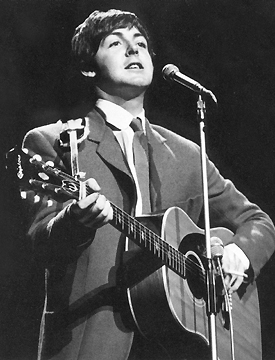
The forcefulness of the Epiphone audio-visual range was matched by the electric line, the almost famous of these was the double-cutaway Casino, start issued in 1961. When the Beatles appeared playing Casinos around 1966, information technology appeared similar Epiphone'south recovery was assured with a new identity and the world's biggest pop human action as their biggest fans. The itemize at present listed 14 electric archtops, vi solid-bodied electrics, three basses, seven steel-string flat tops, vi classical, 4 acoustic archtops, three banjos and a mandolin.
The early to mid-1960s were boom fourth dimension for Epiphone, with unit sales increasing fivefold between 1961 and 1965. Merely the ascent of foreign-made copies in the tardily '60s took over twoscore% of the Epiphone/Gibson market share and closed many companies downwards entirely.
At that place were other problems. Gibson's Ted McCarty had retired to run Bigsby. Budgets were cut. Gibson'south parent company, CMI, was bought in 1969 by the Ecuadorian ECL Corporation, a beer company, and Epiphone found itself in a predicament. It was at present perceived to be secondary to Gibson but could not sell instruments inexpensive enough to compete with inferior, foreign imitations.
Before the auction to ECL, the possibility of producing Epiphone product in Nihon had been taken under consideration and by 1970, Epiphone production in the United States shut down and moved to Matsumoto, Japan. However for the first few years of production, Epiphone guitars fabricated in Japan were actually rebranded designs already produced by the Matsumoku Company. The Epiphone line was now a virtual orphan in the guitar world.
Models gradually improved. In 1976, Epiphone introduced the Monticello, a series of scroll-body electrics, the Presentation, a new range of flat tops, and the Nova series of flat tops along with the Genesis solid body line. By 1979, the Epiphone product listing was gathering speed, with over 20 steel-string apartment tops and electrics.
EPIPHONE IN KOREA
In the early '80s with the rising cost of Japanese production, Epiphone relocated to Korea in 1983 in a collaboration with the Samick Company. In 1986, three Harvard MBAs; Henry Juszkiewicz, David Berryman and Gary Zebrowski, bought Gibson/Epiphone from ECL/Norlin. Reviving Gibson was the first priority for the new owners, and with Epiphone making less than $1 1000000 revenue in 1985, the 100 yr old company was once more set bated.
But new owners Juszkiewicz and Berryman soon identified Epiphone as a sleeping giant and travelled to Korea to determine how the company could be pushed to match the success of other Asian brands like Charvel and Kramer. Equally they captivated Epiphone'south pedigree, models were revived and new production techniques started getting results. Soon, sales were growing over again.
By 1988, the Epiphone listed a new PR Series of square-shouldered acoustics along with an interpretation of Gibson's J-180, several classical guitars, a banjo, and a mandolin. There was likewise a solid selection of Gibson-inspired models similar the Les Paul and SG, new archtops like the Howard Roberts Fusio, and a revival of the Sheraton.
TAKING ON THE WORLD
By the 90s, the Epiphone line offered 43 different models across a range of styles and budgets. Gibson President David Berryman opened an Epiphone an role in Seoul and appointed Jim Rosenberg as production managing director, and gear up about re-introducing Epiphone to the world as an innovative guitar maker.
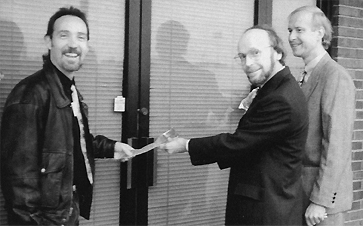
The creation of an office in Seoul turned out to be a major turning betoken for the new Epiphone as engineers and luthiers collaborated to re-brand the company. During this intense re-arrangement, Epiphone product inverse beyond all recognition. Manufactory processes were assessed and refined and Epiphone'south ain engineers took a hands-on role in the development of pickups, bridges, toggle switches, and fret inlays, as well every bit unique features similar the metal E logo and frequensator tailpiece. Financially and emotionally, Epiphone invested everything into these new models. And the market place responded.
Past the time of the 1993 NAMM show, a new range audio-visual and electrical instruments debuted to great reviews and customer response.
In 1993, a limited run of Rivieras and Sheratons were produced in Gibson's Nashville factory, with the visitor'southward Montana plant also building 250 Excellente, Texan and Frontier flat tops. These Epiphones were only intended as a special issue but the public reaction prompted Rosenberg to reissue more classic designs.
Those who attended the 1994 NAMM witnessed the re-introduction of Epiphone legends similar the Casino, Riviera, Sorrento, and Rivoli bass. In the months that followed, word spread, and a diverse range of artists, from Chet Atkins to Oasis' Noel Gallagher signed upwardly to exist function of Epiphone, a confirmation that Epiphone was still a cracking instrument company.
Epiphone was arguably only as successful in the late '90s equally at any betoken in its history. The Advanced Jumbo Serial and several important signature models were released including the John Lee Hooker Sheratons and the Noel Gallagher Supernovas, both a critical and pop success. The John Lennon 1965 and Revolution Casinos matched unbeatable actuality and quality and reunited Epi with ane of the greatest artists of all fourth dimension, underlining the company's own re-emergence every bit a music fable.
In 2000, Epiphone introduced the Elitist range and strengthened its position in the audio-visual marketplace with the conquering of veteran Gibson luthier Mike Voltz. Voltz's contribution greatly to Epiphone's re-development reviving the electric guitar and the reintroduction of the Masterbilt range along with the 2005 re-upshot of the Paul McCartney 1964 USA Texan.
International need for Epiphones was so high that the company opened a new factory in China in 2004, the beginning time that Epiphone had its ain defended factory since the merging with Gibson in 1957.
Today, Epiphone has something for every player in every genre. Working musicians prize Epiphone for its affordable versions of Kalamazoo factory favorites and new models like the Wilshire Phant-o-matic and the Ultra Iii. Collectors of vintage guitars snap upward the accurate Elitist reissues of the Emperor, Casino and Excellente. Epiphone quality rivals that of any guitar manufacturer in the world, while stone 'north' roll fans please in the company's signature models similar the Marcus Henderson Bogeyman, the Zakk Wylde ZV Custom and the Joe Bonamassa Goldtop.
In 2013, as Epiphone celebrates 140 years as the working musician's favorite musical instrument maker, Epiphone still has the pioneering spirit of Epi Stathopoulo. And now, from its new headquarters in Nashville, TN, Epiphone will continue to set the standard for affordable quality and innovation. Epiphone thrives on risk while ever delivering a dandy musical instrument.
"Epiphone is still the Business firm of Stathopoulo. Nosotros're designers. We're players. We're mavericks. And, nosotros're passionate near everything we do."
Source: https://www.epiphone.com/en-US/history
0 Response to "Is Epiphone Le Hummingbird by Artist Better Than Pro 1 Plus Review"
Post a Comment